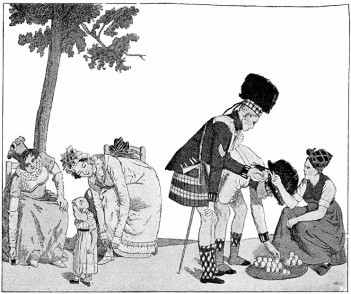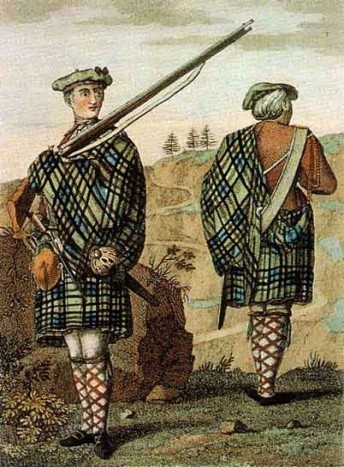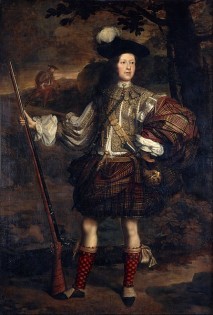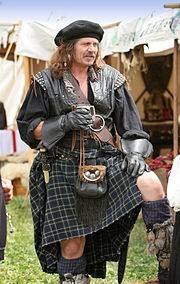
Argyll Kilts Scotlands Premier Kiltmakers
Tel: 0044 (0) 1389-721757



The History of the Kilt stretches back to ancient times. Although the kilt is an item of traditional Scottish Highland Dress, the
nationalism of that tradition is relatively recent. It was only with the Romantic Revival of the 19th century that the kilt became irreversibly associated with Highlanders, and was subsequently adopted by Lowlanders and the Scottish Diaspora. Other modern celts such as the Irish, Cornish, Welsh and Manx, have also adopted Tartan kilts in recent times, although to a lesser degree. Similar clothing had long been abandoned by related cultures such as Gauls, and Scandinavians.
The word kilt comes from the Scots word kilt meaning to tuck up the clothes around the body. The Scots word derives from the Old Norse kjilt, which means "pleated", from Viking settlers who wore a similar, non-tartan pleated garment.
nationalism of that tradition is relatively recent. It was only with the Romantic Revival of the 19th century that the kilt became irreversibly associated with Highlanders, and was subsequently adopted by Lowlanders and the Scottish Diaspora. Other modern celts such as the Irish, Cornish, Welsh and Manx, have also adopted Tartan kilts in recent times, although to a lesser degree. Similar clothing had long been abandoned by related cultures such as Gauls, and Scandinavians.
The word kilt comes from the Scots word kilt meaning to tuck up the clothes around the body. The Scots word derives from the Old Norse kjilt, which means "pleated", from Viking settlers who wore a similar, non-tartan pleated garment.
Highland chieftain wearing belted plaid, around 1680: larger
The Breacan an Fhéilidh or Féileadh Mòr was originally a length of thick woollen cloth made up from two loom widths sewn together to give a total width of 1.5 m, up to 5 m in length. The great kilt, also known as the Belted Plaid, was an untailored Draped Garment made of the Cloth gathered up into pleats by hand and secured by a wide Belt. The upper half could be worn as a Cloak draped over the left shoulder, hung down over the belt and gathered up at the front, or brought up over the shoulders or head for protection against weather. It was worn over a léine (a full sleeved garment gathered along the arm length and stopping below the waist) and could also serve as a camping blanket.
A description from 1746 states:
"The garb is certainly very loose, and fits men inured to it to go through great fatigues, to make very quick marches, to bear out against the inclemency of the weather, to wade through rivers, and shelter in huts, woods, and rocks upon occasion; which men dressed in the low country garb could not possibly endure."
The solid colour kilts of the Irish were also usually soaked in Goose grease to make them waterproof.
For battle it was customary to take off the kilt beforehand and set it aside, the Highland Charge being made wearing only the léine or war shirt.
The age of the great kilt is hotly debated but it certainly existed at the beginning of the 17th Century. Earlier carvings or illustrations appearing to show the kilt may show the Leine Croich, a knee-length Shirt of Leather, Linen or Canvas, heavily pleated and sometimes quilted as protection. The great kilt is mostly associated with the Scottish highlands, but was also used in poor lowland rural areas. Wide-spread use of this type of kilt continued into the 19th Century, and some still wear it today.
The "small kilt" or "walking kilt"
Sometime early in the 18th Century the fèileadh beag or philabeg using a single width of cloth hanging down below the belt came into use and became quite popular throughout the Highlands and northern Lowlands by 1746, though the great kilt also continued in use.
A letter published in the Edinburgh Magazine in March 1785 by one Ivan Baillie argued that the garment people would today recognize as a kilt was invented around the 1720s by Thomas Rawlinson, a Quaker from Lancashire. Rawlinson was claimed to have designed it for the Highlanders who worked in his new Charcoal production facility in the woods of northern Scotland. After the Jacobite campaign of 1715 the government was "opening" the Highlands to outside exploitation and Rawlinson was one of the businessmen who took advantage of the situation. It was thought that the traditional Highland kilt, the "belted plaid" which consisted of a large cloak, was inconvenient for tree cutters. He supposedly brought the Highland garment to a tailor, intent on making it more practical. The tailor responded by cutting it in two. Rawlinson took this back and then introduced the new kilt. Rawlinson liked the new creation so much that he began to wear it as well and was soon imitated by his Scottish colleagues, the Clan MacDonnell of Glengarry.
Numerous illustrations exist of Highlanders wearing only the bottom part of the belted plaid that date long before Rawlinson ever set foot in Scotland. The belted plaid consisted of two widths of material stitched together. If the widths are not stitched together and only the bottom 4 yards are worn pleated and belted around the waist, the resulting garment is called the feilidh-beag (little wrap). The word is often spelled phillabeg in English. There is some suggestion of its use in the early 17th Century, and it was definitely being worn by the 18th century. It most likely came about as a natural evolution of the belted plaid and Rawlinson probably observed it and quickly deduced its usefulness in his situation and insisted on introducing it among his workers. The first instance we have of the pleats being sewn in to the phillabeg, creating a true tailored kilt, comes in 1692, before the time of Rawlinson. This kilt, currently in the possession of the Scottish Tartans Society, is the first garment that can truly be called a kilt as we know it today.
The small kilt developed into the modern tartan kilt when the pleats were sewn in to speed the donning of the kilt.
Proscription and revival of the kilt
The Jacobite Risings demonstrated the dangers to central government of warrior Highland clans answering only to their chieftains, and as part of a series of measures the government of King George 11 imposed the " Dress Act " in 1746, outlawing all items of Highland dress including the new kilts (though with an exception for army uniforms) with the intent of suppressing highland culture. The ban remained in effect for 35 years.
Although the kilt was largely forgotten in the Scottish Highlands, during those years it became fashionable for Scottish Romantics to wear kilts as a form of protest against the ban. This was an age that romanticized "primitive" peoples, which is what Highlanders were viewed as. Most Lowlanders had viewed Highlanders with fear before 1745, but many identified with them after their power was broken. The kilt, along with other features of Gaelic culture, had become identified with Jacobitism, and now that this had ceased to be a real danger it was viewed with romantic nostalgia. Once the ban was lifted in 1782, Highland landowners set up Highland Societies with aims including "Improvements" (which others would call the Highland Clearances) and promoting "the general use of the ancient Highland dress". The Celtic Society of Edinburgh, chaired by Walter Scott, encouraged lowlanders to join this antiquarian enthusiasm.
The kilt became identified with the whole of Scotland with the pageantry of the visit of King George 1V to Scotland in 1822, even though 9 out of 10 Scots lived in the Lowlands. Scott and the Highland societies organised a "gathering of the Gael" and established entirely new Scottish traditions, including Lowlanders wearing the supposed "traditional" garment of the Highlanders. At this time many other traditions such as clan identification by tartan were developed.
After that point the kilt gathered momentum as an emblem of Scottish culture as identified by antiquarians, romantics, and others, who spent much effort praising the "ancient" and natural qualities of the kilt. King George IV had appeared in a spectacular kilt, and his successor Queen Victoria dressed her boys in the kilt, widening its appeal. The kilt became part of the Scottish national identity.
The Breacan an Fhéilidh or Féileadh Mòr was originally a length of thick woollen cloth made up from two loom widths sewn together to give a total width of 1.5 m, up to 5 m in length. The great kilt, also known as the Belted Plaid, was an untailored Draped Garment made of the Cloth gathered up into pleats by hand and secured by a wide Belt. The upper half could be worn as a Cloak draped over the left shoulder, hung down over the belt and gathered up at the front, or brought up over the shoulders or head for protection against weather. It was worn over a léine (a full sleeved garment gathered along the arm length and stopping below the waist) and could also serve as a camping blanket.
A description from 1746 states:
"The garb is certainly very loose, and fits men inured to it to go through great fatigues, to make very quick marches, to bear out against the inclemency of the weather, to wade through rivers, and shelter in huts, woods, and rocks upon occasion; which men dressed in the low country garb could not possibly endure."
The solid colour kilts of the Irish were also usually soaked in Goose grease to make them waterproof.
For battle it was customary to take off the kilt beforehand and set it aside, the Highland Charge being made wearing only the léine or war shirt.
The age of the great kilt is hotly debated but it certainly existed at the beginning of the 17th Century. Earlier carvings or illustrations appearing to show the kilt may show the Leine Croich, a knee-length Shirt of Leather, Linen or Canvas, heavily pleated and sometimes quilted as protection. The great kilt is mostly associated with the Scottish highlands, but was also used in poor lowland rural areas. Wide-spread use of this type of kilt continued into the 19th Century, and some still wear it today.
The "small kilt" or "walking kilt"
Sometime early in the 18th Century the fèileadh beag or philabeg using a single width of cloth hanging down below the belt came into use and became quite popular throughout the Highlands and northern Lowlands by 1746, though the great kilt also continued in use.
A letter published in the Edinburgh Magazine in March 1785 by one Ivan Baillie argued that the garment people would today recognize as a kilt was invented around the 1720s by Thomas Rawlinson, a Quaker from Lancashire. Rawlinson was claimed to have designed it for the Highlanders who worked in his new Charcoal production facility in the woods of northern Scotland. After the Jacobite campaign of 1715 the government was "opening" the Highlands to outside exploitation and Rawlinson was one of the businessmen who took advantage of the situation. It was thought that the traditional Highland kilt, the "belted plaid" which consisted of a large cloak, was inconvenient for tree cutters. He supposedly brought the Highland garment to a tailor, intent on making it more practical. The tailor responded by cutting it in two. Rawlinson took this back and then introduced the new kilt. Rawlinson liked the new creation so much that he began to wear it as well and was soon imitated by his Scottish colleagues, the Clan MacDonnell of Glengarry.
Numerous illustrations exist of Highlanders wearing only the bottom part of the belted plaid that date long before Rawlinson ever set foot in Scotland. The belted plaid consisted of two widths of material stitched together. If the widths are not stitched together and only the bottom 4 yards are worn pleated and belted around the waist, the resulting garment is called the feilidh-beag (little wrap). The word is often spelled phillabeg in English. There is some suggestion of its use in the early 17th Century, and it was definitely being worn by the 18th century. It most likely came about as a natural evolution of the belted plaid and Rawlinson probably observed it and quickly deduced its usefulness in his situation and insisted on introducing it among his workers. The first instance we have of the pleats being sewn in to the phillabeg, creating a true tailored kilt, comes in 1692, before the time of Rawlinson. This kilt, currently in the possession of the Scottish Tartans Society, is the first garment that can truly be called a kilt as we know it today.
The small kilt developed into the modern tartan kilt when the pleats were sewn in to speed the donning of the kilt.
Proscription and revival of the kilt
The Jacobite Risings demonstrated the dangers to central government of warrior Highland clans answering only to their chieftains, and as part of a series of measures the government of King George 11 imposed the " Dress Act " in 1746, outlawing all items of Highland dress including the new kilts (though with an exception for army uniforms) with the intent of suppressing highland culture. The ban remained in effect for 35 years.
Although the kilt was largely forgotten in the Scottish Highlands, during those years it became fashionable for Scottish Romantics to wear kilts as a form of protest against the ban. This was an age that romanticized "primitive" peoples, which is what Highlanders were viewed as. Most Lowlanders had viewed Highlanders with fear before 1745, but many identified with them after their power was broken. The kilt, along with other features of Gaelic culture, had become identified with Jacobitism, and now that this had ceased to be a real danger it was viewed with romantic nostalgia. Once the ban was lifted in 1782, Highland landowners set up Highland Societies with aims including "Improvements" (which others would call the Highland Clearances) and promoting "the general use of the ancient Highland dress". The Celtic Society of Edinburgh, chaired by Walter Scott, encouraged lowlanders to join this antiquarian enthusiasm.
The kilt became identified with the whole of Scotland with the pageantry of the visit of King George 1V to Scotland in 1822, even though 9 out of 10 Scots lived in the Lowlands. Scott and the Highland societies organised a "gathering of the Gael" and established entirely new Scottish traditions, including Lowlanders wearing the supposed "traditional" garment of the Highlanders. At this time many other traditions such as clan identification by tartan were developed.
After that point the kilt gathered momentum as an emblem of Scottish culture as identified by antiquarians, romantics, and others, who spent much effort praising the "ancient" and natural qualities of the kilt. King George IV had appeared in a spectacular kilt, and his successor Queen Victoria dressed her boys in the kilt, widening its appeal. The kilt became part of the Scottish national identity.
Highland soldier in 1744, an early picture of a Government Tartan great kilt, with the Plaid being used to protect the Musket lock from rain and wind.
Satirical caricature of European women curious about kilted Scottish soldiers, ca. 1815
From 1624 the Independent Companies of Highlanders had worn kilts as government troops, and with their formation into the Black Watch regiment in their great kilt uniform was standardised with a new dark tartan.
Many Jacobite rebels adopted kilts as an informal uniform, with even their English supporters wearing tartan items during the Jacobite Rising of 1745. In the aftermath of that rebellion the Government decided to form more Highland regiments for the army in order to direct the energies of Gaels, that "hardy and intrepid race of men". In doing so they formed effective new army regiments to send to fight in India, North America, and other locations while lowering the possibility of rebellion at home. Army uniforms were exempt from the ban on wearing kilts in the " Dress Act ", and as a means of identification the regiments were given different tartans. These regiments opted for the modern kilts for dress uniforms, and while the great kilt remained as undress uniform this was phased out by the early 19th Century.
Scottish troops last wore kilts in combat during WWI. In particular, the ferocious tactics of the Royal Highland Regiment led to their acquiring the nickname "Ladies from Hell" from the German troops that faced them in the trenches.
Irish troops have no tradition of wearng the kilt in battle, though pipers in Irish regiments of the British Army have traditionally worn a mustard-colored saffron kilt.
From 1624 the Independent Companies of Highlanders had worn kilts as government troops, and with their formation into the Black Watch regiment in their great kilt uniform was standardised with a new dark tartan.
Many Jacobite rebels adopted kilts as an informal uniform, with even their English supporters wearing tartan items during the Jacobite Rising of 1745. In the aftermath of that rebellion the Government decided to form more Highland regiments for the army in order to direct the energies of Gaels, that "hardy and intrepid race of men". In doing so they formed effective new army regiments to send to fight in India, North America, and other locations while lowering the possibility of rebellion at home. Army uniforms were exempt from the ban on wearing kilts in the " Dress Act ", and as a means of identification the regiments were given different tartans. These regiments opted for the modern kilts for dress uniforms, and while the great kilt remained as undress uniform this was phased out by the early 19th Century.
Scottish troops last wore kilts in combat during WWI. In particular, the ferocious tactics of the Royal Highland Regiment led to their acquiring the nickname "Ladies from Hell" from the German troops that faced them in the trenches.
Irish troops have no tradition of wearng the kilt in battle, though pipers in Irish regiments of the British Army have traditionally worn a mustard-colored saffron kilt.







